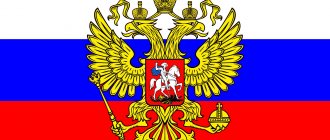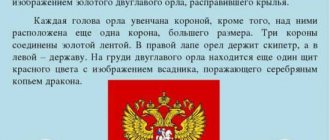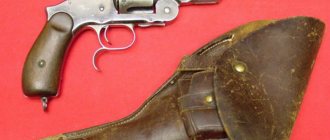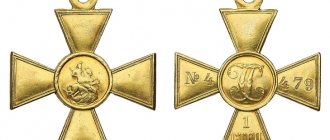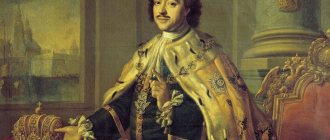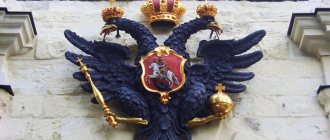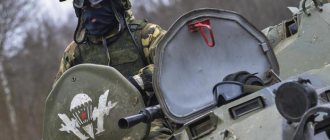Seal of Ivan III the Great
Each state has its own symbols that reflect its internal structure: power, territory, natural features and other priorities. One of the symbols of the state is the coat of arms.
The coat of arms of each country has its own history of creation. There are special rules for drawing up a coat of arms; this is done by the special historical discipline of HERALDICS, which developed back in the Middle Ages.
The history of the coat of arms of the Russian Empire is quite interesting and unique.
Officially, Russian heraldry begins with the reign of Alexei Mikhailovich Romanov (XVII century). But the forerunner of the coat of arms were the personal seals of the Russian tsars, so the primary sources of the Russian coat of arms should be sought in the 15th century, during the reign of Ivan III the Great. Initially, the personal seal of Ivan III depicted St. George the Victorious, striking a serpent with a spear - a symbol of Moscow and the Moscow Principality. The double-headed eagle was adopted on the state seal after the wedding in 1472 of Ivan III the Great with Sophia (Zoe) Paleologus, the niece of the last emperor of Byzantium, Constantine Paleologus. It symbolized the transfer of the legacy of the fallen Byzantium. But before Peter I, the Russian coat of arms was not subject to heraldic rules; Russian heraldry developed precisely during his reign.
History of the coat of arms double-headed eagle
The eagle in the coat of arms dates back to Byzantium. Later he appeared on the coat of arms of Rus'. The image of an eagle is used in the coats of arms of many countries of the world: Austria, Germany, Iraq, Spain, Mexico, Poland, Syria, and the USA. But the double-headed eagle is present only on the coats of arms of Albania and Serbia. The Russian double-headed eagle has undergone many changes since its appearance and emergence as an element of the state emblem. Let's look at these stages. As mentioned above, coats of arms appeared in Russia a long time ago, but these were only drawings on the seals of the kings, they did not obey heraldic rules. Due to the lack of knighthood in Rus', coats of arms were not very common. Until the 16th century, Russia was a divided state, so there could be no talk of a state emblem of Russia. But under Ivan III (1462-1505), his seal acted as a coat of arms. On its front side there is a picture of a horseman piercing a serpent with a spear, and on the back side there is a double-headed eagle. The first known images of a double-headed eagle date back to the 13th century BC. - This is a rock carving of a double-headed eagle grabbing two birds with one stone. This was the coat of arms of the Hittite kings. The double-headed eagle was a symbol of the Median kingdom - an ancient power in the territory of Western Asia under the Median king Cyaxares (625-585 BC). The double-headed eagle then appeared on the emblems of Rome under Constantine the Great. After the founding of the new capital, Constantinople, in 330, the double-headed eagle became the state emblem of the Roman Empire. After the adoption of Christianity from Byzantium, Rus' began to experience the strong influence of Byzantine culture and Byzantine ideas. Along with Christianity, new political orders and relations began to penetrate into Rus'. This influence especially intensified after the marriage of Sophia Paleolog and Ivan III. This marriage had important consequences for the monarchical power in Moscow. As a spouse, the Grand Duke of Moscow becomes the successor of the Byzantine emperor, who was considered the head of the entire Orthodox East. In relations with small neighboring lands, he already bears the title of Tsar of All Rus'. Another title, "autocrat", is a translation of the Byzantine imperial title autocrator ; initially it meant the independence of the sovereign, but Ivan the Terrible gave it the meaning of the absolute, unlimited power of the monarch. Since the end of the 15th century, the Byzantine coat of arms - a double-headed eagle - appears on the seals of the Moscow sovereign; it is combined with the former Moscow coat of arms - the image of St. George the Victorious. Thus, Rus' confirmed the continuity from Byzantium.
Horde flags
In domestic sources, there is practically no reliable information about the symbols of the Russian lands of the 13th-15th centuries. But something can be found in European sources - geographical maps and atlases. Geographers of that time often depicted cities on the map as a fortress, and the city's nationality as a flag above this fortress. On maps of the 14th century, Russian cities are crowned with flags with the Horde tamga.
For example, on the map of Andezhino Dulcerta (Dalorto) of 1339, the territory RUTENIA is marked in large letters, next to it are the “Russian mountains”, in the area of which the Dnieper River begins, and the cities of Moscow (moscaov), Rostov (rostaov), Ryazan ( rasanpaslao), Novgorod (nogardo). Above each fortress there are flags with the Horde tamga.
Moscow and Rostov under the Horde flags on the map of Angelino Dulcerta 1339
Approximately the same thing is depicted in the Catalan atlas of Abraham Cresca of 1375 ; Tver (tifer) is marked east of Rostov under the same Horde flag, but the flag panel is painted green. In the area of the Horde capital Sarai, “Emperor Janibek” is depicted with exactly the same flag.
Tana and Tver on the map of Abraham Kreskes. 1375 Both cities are under green flags with the Horde tamga.
Horde tamga of this type (in the shape of the letter “P” with a ball at the top and a crescent next to it) was well known and, let’s say, “promoted” in Europe. It was repeated in many geographical works. For example, in “Cosmography” by Sebastian Munster, exactly such a tamga was depicted on the shield of a Tatar warrior. Its prototype is the coins of the Horde khans.
Tatar warrior (Tartarus) on the cover of “Cosmography” by Sebastian Munster. On the right is a Horde coin with tamga.
It is interesting that on the map of the Pitsigani brothers (1367) white flags with red squares (tamga?) are depicted above some Russian cities, and above Moscow the same square (tamga?) is black.
Russian cities on the map of the Pitsigani brothers (1367). The blue arrow shows Moscow under a flag with a black square.
From Ivan III to Peter I
Great state seal of Tsar Ivan IV Vasilyevich (the Terrible)
The development of the Russian coat of arms is inextricably linked with the history of Rus'. The eagle on the seals of John III was depicted with a closed beak and looked more like an eaglet. Russia at that time was still an eaglet, a young state. During the reign of Vasily III Ioannovich (1505-1533), the double-headed eagle is depicted with open beaks, from which tongues protrude. At this time, Russia was strengthening its position: the monk Philotheus sent a message to Vasily III with his theory that “Moscow is the Third Rome.”
During the reign of John IV Vasilyevich (1533-1584), Rus' gained victories over the Astrakhan and Kazan kingdoms and annexed Siberia. The power of the Russian state is also reflected in its coat of arms: the double-headed eagle on the state seal is crowned with a single crown with an eight-pointed Orthodox cross above it. Obverse side of the seal: on the chest of the eagle there is a carved German shield with a unicorn - the personal sign of the king. All symbols in the personal symbolism of John IV are taken from the Psalter. Reverse side of the seal: on the eagle’s chest is a shield with the image of St. George the Victorious.
On February 21, 1613, the Zemsky Sobor elected Mikhail Fedorovich Romanov to the throne. His election put an end to the unrest that took place in the period after the death of Ivan the Terrible. The eagle on the coat of arms of this period spreads its wings, which means a new era in the history of Russia, which at this time became a unified and fairly strong state. This circumstance is immediately reflected in the coat of arms: above the eagle, instead of an eight-pointed cross, a third crown appears. The interpretation of this change is different: a symbol of the Holy Trinity or a symbol of the unity of Great Russians, Little Russians and Belarusians. There is also a third interpretation: the conquered Kazan, Astrakhan and Siberian kingdoms. Alexey Mikhailovich Romanov (1645-1676) ends the Russian-Polish conflict with the conclusion of the Truce of Andrusovo with Poland (1667). The Russian state becomes equal in rights with other European states. During the reign of Alexei Mikhailovich Romanov, the eagle received symbols of power: a scepter and an orb .
Great state seal of Tsar Alexei Mikhailovich
At the request of the tsar, the Holy Roman Emperor Leopold I sent his king of arms Lavrentiy Khurelevich to Moscow, who in 1673 wrote an essay “On the genealogy of the Russian great princes and sovereigns, showing the existing, through marriages, affinity between Russia and eight European powers, that is Caesar of Rome, the kings of England, Denmark, Spain, Poland, Portugal and Sweden, and with the image of these royal coats of arms, and in the middle of them the Grand Duke St. Vladimir, at the end of the portrait of Tsar Alexei Mikhailovich.” This work marked the beginning of the development of Russian heraldry. The eagle’s wings are raised up and fully open (a symbol of the complete establishment of Russia as a powerful state; its heads are crowned with three royal crowns; on its chest there is a shield with the Moscow coat of arms; in its paws there is a scepter and an orb.
Lavrenty Khurelevich in 1667 was the first to give an official description of the Russian coat of arms: “The double-headed eagle is the sovereign coat of arms of the Great Sovereign, Tsar and Grand Duke Alexei Mikhailovich of All Great and Lesser and White Russia, the autocrat, His Royal Majesty of the Russian Empire, on which three crowns are depicted, signifying the three great Kazan, Astrakhan, Siberian glorious kingdoms, submitting to the God-protected and highest power of His Royal Majesty, the Most Gracious Sovereign... on the Persians is the image of the heir; in the box there is a scepter and an apple, and they reveal the most merciful Sovereign, His Royal Majesty the Autocrat and Possessor.”
"The Book of Knowledge of All Kingdoms"
One of the most beloved ancient sources by heraldists and flag scholars all over the world is the work of a Franciscan monk of the mid-14th century, “The Book of Knowledge of all the kingdoms, lands and possessions that exist in the world, the coats of arms and emblems of each land and possession or the kings and rulers who own them.”
(El libro del conoscimiento de todos los reinos). The monk's work was written in Spanish between 1350 and 1360, the monk talks about his travels around the world, and also talks about the coats of arms or flags of the countries he visited. Coats of arms and flags are also given as illustrations of the monk's work. Two copies of his work are in the National Library in Madrid, one in the Royal Library. Fortunately, the texts and drawings from the monk’s work have already been republished many times in our time, that is, they are available for study.
To be honest, I’m almost sure that the monk did not participate in any travels, but wrote his work by “traveling” with a pencil and compass on a geographical map, using and summarizing (possibly) the notes of other travelers. In any case, in addition to completely reliable information about the ancient world, his work also contains a chapter about a visit to the land of people with dog heads, which is unlikely to have happened in reality...
An additional difficulty in “deciphering” the monk’s writings is represented by geographical names that are almost impossible to identify. Apparently, the monk found them in other handwritten geographical works, and in addition to the mistakes of the first authors, he also added his own. In general, almost half of the settlements he mentions (especially in Asia) cannot be identified.
Several fragments of the monk’s work are devoted to travel through the lands of Western Rus' and, possibly, Moscow Rus'.
So, after describing Polonia (Poland), the monk writes:
“... I left the kingdom of Polonia and arrived in the kingdom of Leon, which the Germans call Lumbrek, in which there are five large cities. They are called, the first Leon, the second China, also Vasadino, and Tinez. It is known that the Kingdom of Leon borders the Kingdom of Rumenia and the Kingdom of Suava. The king has a green flag with a red cross on it."
Flag and coat of arms of the “Kingdom of Leon” from the work of the Franciscan monk “The Book of Knowledge of All Kingdoms...”
It can be said with reasonable certainty that the “Kingdom of Leon” is the Russian lands around the city of Lvov
, which the Germans call Lemberg. We can assume that “China” is Kyiv. It’s more difficult with other cities.
By the way, it is precisely these green flags with red crosses that are depicted above the conventional images of the cities of Krakow (Cracovia) and Lviv (Ciudad Leo) on the map of Abraham Kreskes of 1375. That is, either the green flag of Lviv had a real prototype, or Creskes simply “copied” it from a Franciscan monk.
Coat of arms of the “City of the Lion” in the Catalan atlas (c. 1375) by Abraham Cresques. On the right side you can see a fragment of exactly the same green flag of Krakow.
Let's continue:
«…
I left the city of Sara and headed down the Tire River to its confluence with the Tanai. The cities that I met along the banks of the Tanay: Baltachinka, Esclerza, Tifera, Koranchi, which were the capitals of the kingdoms…. belonging to the Sara Empire. These are rich and well-supplied lands with many herds of camels, cows and bulls...
I reached the province of Sebur, with a great city called Casorama, its capital. The kingdom was surrounded by two rivers, the Tire and the Tanai. I left the kingdom of Sebur and reached the cities of Taskoar and Pidea. Here I crossed the Tanay River and entered a large province called Roxia, in which was the city of Xorman."
Tifer, this is apparently Tver. Sebur is possibly the Seversky principality, Kasorama is very vaguely similar to Kostroma, this city is indeed very ancient and was already widely known in the 14th century. But because These cities are not marked with any symbols, flags or coats of arms, then they are of no interest to us. But “Roshiya” is most likely Russia - i.e. Western Rus' with its center in the city of Kholm
(Holm was once the capital of Chervona Rus, now on the territory of Poland). The Franciscan friar shows for Schorman a coat of arms in the form of an eight-pointed star and a flag with two crescents.
Russia between Mazovia and Podolia on the map “Tabvla Moderna Sarmatiae Eur.” from the Latin edition of Ptolemy's Geography, 1513. One of the main cities is Chelmen. In addition to this Russia, the map also shows White Russia under the rule of Muscovy (the left bank of the Dnieper) and the Principality of Muscovy itself.
» This river borders the large province of Sikkia, a very cold country. In Sikkia there is a great city, the capital of the kingdom, Nogarado. The king has as his emblem a red flag with a white castle. I left Sikkia and entered another kingdom called Shsorman, which had a large city with the same name, the capital. After leaving Shorman, I arrived in Machar (MAXAR) - a kingdom in which there are three cities Kasama, Lasak and Manscaor (MANSCAOR). This kingdom lies between the kingdoms of Vogarado and Silvana. King Machara has as his emblem a purple flag with white stars."
Symbols of Shorman, Roshii, Machar in various modern reprints of the “Book of Knowledge of All Kingdoms...”.
Nogarado and Sikkia most likely Veliky Novgorod
and the Russian lands traditionally called Scythia by Europeans.
It can be assumed that by Manskaor and Machar the author means Moscow and Muscovy
. It is curious that the English publisher (and this is the London Haklut Society) made a typo in the modern book, calling Machar’s flag ORENBURG in the caption. Unfortunately, my native Orenburg was founded 400 years after the “journey” of the Franciscan monk. It's a pity.
FROM Machar I went to the Kingdom of Silouana, which is also called Septen Kastra and the Greeks call it Horgimi. It is framed by two large rivers Turbo and Lusim (the British believe that these are the Dnieper and Dniester). In this city there is a large city called Sarah (SARAX). The king's emblem is a green flag with a red scimitar. The people are Orthodox Christians.
Following the Tire River northward I encountered two large provinces, Ircania and Gothia. ... This is called the land of NOGULAUS. The people are strong and warlike, and their country is very cold."
Turbo and Lusim, this is possible Dnepr and Dniester, i.e. We are talking about modern Moldova. It is noteworthy that the coat of arms of Iran shown in the figure is very reminiscent of the sign of the Kyiv princes - the trident (distributed quite widely in ancient Rus', from the Dnieper to Novgorod).
Coat of arms of Irkania in various modern reprints of the “Book of Knowledge of All Kingdoms...”.
From Peter I to Alexander II
Coat of arms of Peter I
Peter I ascended the Russian throne in 1682. During his reign, the Russian Empire became an equal among the leading powers of Europe. Under him, according to heraldic rules, the coat of arms began to be depicted as black (before that it was depicted as gold). The eagle has become not only a decoration of state papers, but also a symbol of strength and power. In 1721, Peter I accepted the imperial title, and imperial crowns began to be depicted on coats of arms instead of royal crowns. In 1722, he established the office of the King of Arms and the position of King of Arms. The state emblem under Peter I also underwent other changes: in addition to changing the color of the eagle, shields with the coats of arms of the Grand Duchies and Kingdoms were placed on its wings. On the right wing there were shields with the coats of arms (from top to bottom): Kyiv, Novgorod, Astrakhan; on the left wing: Vladimir, Siberian, Kazan. It was under Peter I that a complex of attributes of the coat of arms eagle emerged. And after Russia entered the “expanses of Siberia and the Far East,” the double-headed eagle began to symbolize the inseparability of European and Asian Russia under one imperial crown, since one crowned head looks to the west, the other to the east. The era after Peter I is known as the era of palace coups. In the 30s of the 18th century. the leadership of the state was dominated by immigrants from Germany, which did not contribute to the strengthening of the country. In 1736, Empress Anna Ioannovna invited a Swiss by birth, the Swedish engraver I. K. Gedlinger, who engraved the State Seal by 1740, which was used with minor changes until 1856.
Until the end of the 18th century. There were no special changes in the design of the coat of arms, but during the times of Elizabeth Petrovna and Catherine the Great, the eagle looked more like an eagle.
Coat of arms of Catherine I
Two-headed bird of Hinduism
In Hindu mythology, the two-headed bird Gandaberunda is endowed with great magical power. She is able to withstand destruction. A beautiful legend was invented about the appearance of this creature. According to him, the supreme god Vishnu defeated the demon, turning into the image of a mixture of a man and a lion, Narasimha. However, even after he won the victory and drank the blood of his enemy, anger continued to seethe within him and he remained in a terrible image. Everyone was afraid of him, and so the demigods asked Shiva for help. God turned into the eight-legged creature Sharabha, whose strength and power surpassed Narasimha. Then Vishnu reincarnated as Gandaberunda, and in these images the two deities began to fight. Since then, in Hinduism, a two-headed bird has meant colossal, destructive power.
The oldest surviving image of a bird is in India on a statue created in 1047. To show the enormous power of this creature, it was depicted carrying elephants and lions in its claws and beaks. Today this emblem appears on the coat of arms of the Indian state of Karnataka.
Paul I
Coat of arms of Russia with the Maltese cross
Having become emperor, Paul I immediately tried to modify the Russian coat of arms. By decree of April 5, 1797, the double-headed eagle became an integral part of the coat of arms of the imperial family. But since Paul I was the Master of the Order of Malta, this could not but be reflected in the state emblem. In 1799, Emperor Paul I issued a decree on the image of a double-headed eagle with a Maltese cross on the chest. The cross was placed on the eagle's chest under the Moscow coat of arms ("indigenous coat of arms of Russia"). The emperor is also making an attempt to develop and introduce a complete coat of arms of the Russian Empire. At the upper end of this cross was placed the crown of the Grand Master. In 1800, he proposed a complex coat of arms, on which forty-three coats of arms were placed in a multi-field shield and on nine small shields. However, they did not have time to adopt this coat of arms before Paul’s death. Paul I was also the founder of the Great Russian Coat of Arms. The Manifesto of December 16, 1800 gives its full description. The large Russian coat of arms was supposed to symbolize the internal unity and power of Russia. However, Paul I's project was not implemented. Alexander I, having become emperor in 1801, abolished the Maltese cross on the state emblem. But under Alexander I, on the coat of arms, the eagle’s wings are spread wide to the side, and the feathers are lowered down. One head is more inclined than the other. Instead of a scepter and an orb, new attributes appear in the eagle’s paws: a torch, peruns (thunder arrows), a laurel wreath (sometimes a branch), a lictor’s bun intertwined with ribbons.
Nicholas I
Coat of arms of Nicholas I
The reign of Nicholas I (1825-1855) was emphatically firm and decisive (suppression of the Decembrist uprising, limitation of the status of Poland). Under him, from 1830, the armorial eagle began to be depicted with sharply raised wings (this remained so until 1917). In 1829, Nicholas I was crowned the Kingdom of Poland, therefore, since 1832, the coat of arms of the Kingdom of Poland has been included in the Russian coat of arms. At the end of the reign of Nicholas I, the manager of the heraldry department, Baron B.V. Kene, tried to give the coat of arms the features of Western European heraldry: the image of the eagle should have become more strict. The coat of arms of Moscow was to be depicted in a French shield; the rider was to be turned, according to heraldic rules, to the left of the viewer. But in 1855, Nicholas I died, and Quesne’s projects were implemented only under Alexander II.
Large, Middle and Small coats of arms of the Russian Empire
Large state emblem of the Russian Empire 1857
The large state emblem of the Russian Empire was introduced in 1857 by decree of Emperor Alexander II (this was the idea of Emperor Paul I). The large coat of arms of Russia is a symbol of the unity and power of Russia. Around the double-headed eagle are the coats of arms of the territories that are part of the Russian state. In the center of the Great State Emblem is a French shield with a golden field on which a double-headed eagle is depicted. The eagle itself is black, crowned with three imperial crowns, which are connected by a blue ribbon: two small ones crown the head, the large one is located between the heads and rises above them; in the eagle’s paws are a scepter and an orb; on the chest is depicted “the coat of arms of Moscow: in a scarlet shield with gold edges, the Holy Great Martyr George the Victorious in silver armor and an azure cap on a silver horse.” The shield, which depicts an eagle, is topped with the helmet of the Holy Grand Duke Alexander Nevsky, around the main shield is a chain and the Order of St. Andrew the First-Called. On the sides of the shield there are shield holders: on the right side (to the left of the viewer) is the Holy Archangel Michael, on the left is the Archangel Gabriel. The central part is under the shadow of the large imperial crown and the state banner above it. To the left and right of the state banner, on the same horizontal line with it, are depicted six shields with the connected coats of arms of the principalities and volosts - three to the right and three to the left of the banner, almost creating a semicircle. Nine shields, crowned with crowns with the coats of arms of the Grand Duchies and Kingdoms and the coat of arms of His Imperial Majesty, are a continuation and most of the circle that the united coats of arms of the principalities and volosts began. Coats of arms counterclockwise: the Astrakhan Kingdom, the Siberian Kingdom, the Family Coat of Arms of His Imperial Majesty, the united coats of arms of the Grand Duchies, the coat of arms of the Grand Duchy of Finland, the coat of arms of Chersonis-Tauride, the coat of arms of the Polish Kingdom, the coat of arms of the Kazan Kingdom. The top six shields from left to right: combined coats of arms of the principalities and regions of the Great Russian, combined coats of arms of the principalities and regions of the South-Western, combined coats of arms of the Baltic regions. At the same time, the Middle and Small state emblems were adopted. The middle state coat of arms was the same as the Great one, but without state banners and six coats of arms above the canopy; Small - the same as the Middle one, but without a canopy, images of saints and the family coat of arms of His Imperial Majesty. Adopted by decree of Alexander III on November 3, 1882, the Great State Emblem differed from that adopted in 1857 in that it added a shield with the coat of arms of Turkestan (became part of Russia in 1867), combined the coats of arms of the principalities of Lithuania and Belarusian. The large state emblem is framed by laurel and oak branches - a symbol of glory, honor, merit (laurel branches), valor, courage (oak branches). The Great State Emblem reflects “the triune essence of the Russian idea: For the Faith, the Tsar and the Fatherland.” Faith is expressed in the symbols of Russian Orthodoxy: many crosses, Saint Archangel Michael and Saint Archangel Gabriel, the motto “God is with us,” the eight-pointed Orthodox cross above the state banner. The idea of an autocrat is expressed in the attributes of power: a large imperial crown, other Russian historical crowns, a scepter, an orb, and a chain of the Order of St. Andrew the First-Called. The Fatherland is reflected in the coat of arms of Moscow, the coats of arms of Russian and Russian lands, in the helmet of the Holy Grand Duke Alexander Nevsky. The circular arrangement of the coats of arms symbolizes equality between them, and the central location of the coat of arms of Moscow symbolizes the unity of Rus' around Moscow, the historical center of Russian lands.
Ancient Greece
In the mythology of the ancient Greeks, there was a sun god - Helios. He could move across the sky in a chariot harnessed to four horses. This was a common image that was placed on walls. However, there was something else: instead of horses, the chariot was harnessed by two double-headed eagles - black and white. This image has not yet been precisely interpreted, however, it is believed that there is a secret meaning hidden in it. Here you can trace an interesting chain: the eagle is the king of birds, and the Sun is the “king” of the planets. It is this bird that flies higher than others and approaches the divine luminary.
